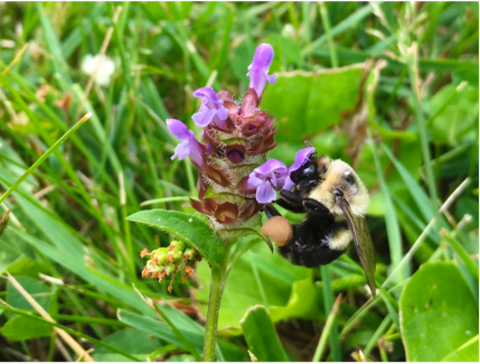UMN Extension has new materials on everything you need to know to grow your own bee lawn! UMN researchers have spent several years studying bee lawns and the pollinators that benefit from them. These resources combine the results of all this work so everyone can learn the steps in establishing and maintaining a bee lawn.
What is a bee lawn?
A bee lawn has turfgrasses just like the lawn you may already have, but they also include specific flowers that do a good job of providing food for bees and other pollinators. According to UMN research, the easiest and most effective flowers to incorporate into a bee lawn are white clover, self-heal and creeping thyme.
One of the goals of a bee lawn is that, unlike a flower garden, it will still be available for use by people and pets for recreation, while providing other lawn ecosystem services like stormwater capture and urban cooling.
Benefits of bee lawns for pollinators
Native bee species are declining due to habitat loss and other causes (pesticides, disease, and parasites) so anything you can do to provide more flowers that have pollen and nectar for them may help.
There are over 400 species of bees in Minnesota and UMN research has shown that over 50 bee species may be found on the flowers of a bee lawn. This doesn’t even include all the other pollinators such as butterflies, moths, flies, beetles and wasps.
The more people that have pollinator plantings including bee lawns, as well as diverse habitat for bees, the better.
Benefits of bee lawns for you
- Bee lawns can actually be less yard work once they are established because they need less water and fertilizer. We recommend fine fescues for the turfgrass part of a bee lawn for this reason.
- Lawns don’t always have to be plain old green. Bee lawns can be aesthetically pleasing with their variety of white, purple and pink flowers mixed in among the shades of green of turfgrasses.
- More pollinators in your yard means more pollination for your homegrown fruit and vegetables. Many of the plants grown for food either need to be pollinated by insects or yield better with pollination.
- Watching all the species of pollinators flying and fluttering about in your bee lawn can be a fun and relaxing activity. You may be amazed at all the diversity of insects you see!
- As an added bonus, you can be an inspiration to others to plant more pollinator plants. Research proves there is a cluster effect in neighborhood landscaping changes; one early adopter can inspire neighbors to take on sustainable landscape practices such as a bee lawn.
Other ways to help pollinators
Bee lawns are just one small part of helping Minnesota’s bees. Pollinators need flowers all growing season long such as in early spring before bee lawns are blooming. They also need different kinds of habitat for their nests as lawns generally are not the best place for nests.
These resources can help you learn more about helping pollinators:
- The University of Minnesota Bee Lab
- Growing landscapes to help bees and other pollinators
- Help wild pollinators
Don’t forget to consult our new page, Planting and maintaining a bee lawn, whenever you have bee lawn questions!


